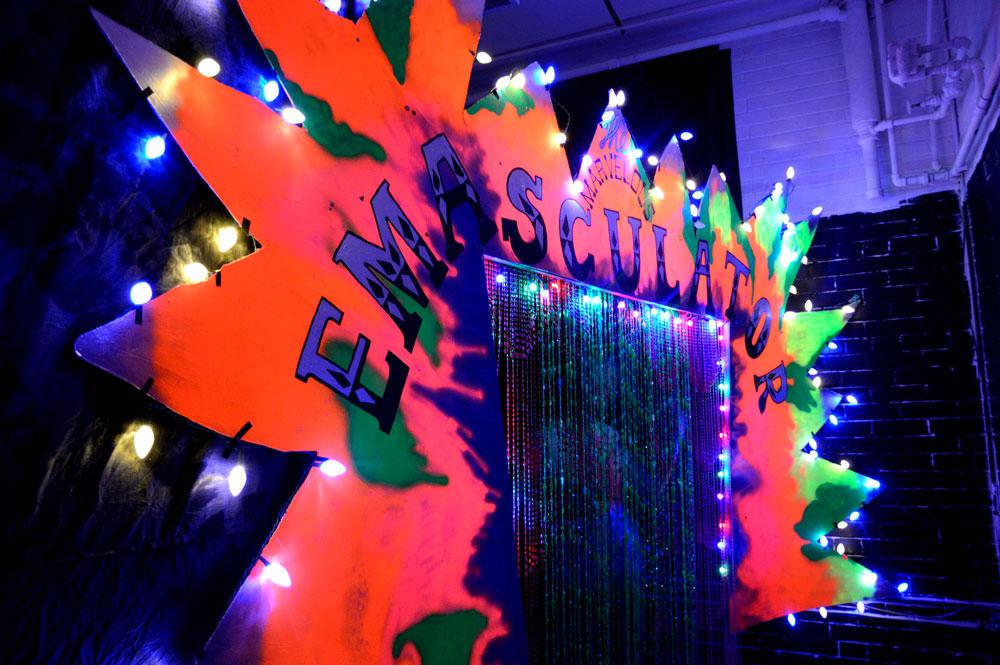Anticipation and spookiness were in no short supply in the long lineup for the opening performance at Kill Joy’s Kastle, Allyson Mitchell’s lesbian-feminist haunted house, an AGYU offsite project located where College and Dundas streets meet in Toronto’s West End. Outside, a performer covered in crocheted coat hangers cackled and screamed “My body my choice!” as a crowd gathered in the alleyway. A zombie character sidled up behind unsuspecting groups of waiting visitors and smacked her lips next to their ears, moaning “I smell feminist brains!”
Anticipating entry into the haunted house plays a huge role in the spectacle. Much like other crowded art events, such as Nuit Blanche, Kill Joy’s Kastle‘s atmosphere of experimentation, silliness and provocation was infectious. On opening night, a stranger on the upper floor of the building that houses the installation donned a long black dress and hat and danced in front of her window– giving an impression of vastness to the Haunted House, and suggesting anything might happen inside. The house, which riffs on the American evangelical Christian tradition of Halloween hell houses, equipped with performers who act out the dangers of so-called deviant acts, casts these acts in a new light, as manifestations of the spectres, stereotypes and fears of queerness and feminism.
A performer costumed as Valerie Solanas (the late, contentious Marxist-feminist writer and attempted Warhol assassin) briefed us on house rules: respect performers’ personal spaces; sit when asked; be aware of nudity inside. Finally she warned us, “You know that app you have on your phone that’s a flashlight? Don’t fuckin’ use it. Use the light that emanates from our cunts and leads towards the revolution!”
The installation plays with the abrasive tendencies and perceptions of radical feminism: that it’s filled with man-haters, ball-busters, pro-choicers, polyamorists and witchy punks. Inside, we could hear the strains of a misandrist folk singalong. Hand-painted signs playfully advertised and warned us about severed penises, hair-braiding, pussy juice, indoctrination and lesbian performance art. At once, they cautioned, “No satanic transphobic humans allowed,” and “This ain’t no Woman Haus.”
Inside, visitors were greeted by “demented women’s studies professors” who accompanied them through the installation, embodying the liberatory and comedic potential of killjoy-ing, and acting as “murderers of fun.” At key points these frazzled, over-qualified and underpaid docents (coy critiques of the academy) guided us through the origins of the tropes we were about to see brought to life. They led us past the friendly, touchy-feely-but-don’t-get-too-close-to-it bearded clam, the dank cave dweller (a figure in an alcove filled with exaggerated slurping, wearing an intoxicated grin and two long, spindly fingers), the plaid-clad butch lesbians who worked all night symbolically smashing plaster casts of truck nuts, and the polyamorous vampiric grannies made from stuffed nylons whose fingers had become “super-evolved to slide over delicate pleasure centres.”
While populated by humourous, absurd and often soft and inviting figures, the installation also deals with the very real anxiety of entering into the vital yet fraught territory of feminism. Passing through a dark corridor filled with moaning and whispering, we lost our ability to see. I found myself clutching for the hands of my compatriots in desperation but also in closeness.
A section near the end of the installation reads as somewhere between a queer-feminist library, a high-school hallway, and a dance party. Inside, ghostly nymph zombies in masks and slip dresses danced wildly, while others aggressively stared visitors down. The experience was truly frightening: I found myself backed up against a bank of lockers, looked back to see “Dyke” scrawled across them, and became unsure whether I should dance with the figures or engage in a staring contest. I shrank into a sort of pubescent awkwardness and unbelonging. Amid the sense of lesbian-feminist revelry, it was a visceral reminder that, for many, experiences of queer and feminist communities are often (and still) accompanied by a sense of alienation and confusion rather than warm acceptance. This final portion of the installation highlights the immense potential of the project, which successfully manages at once to satirize those evangelical scare-tactics and homophobic stereotypes, and to provide a sense of the systems of exclusion which operate within radical communities.
The latter is currently playing out in interesting and productive ways in online communities. A review by Toronto-based multimedia artist Kalmplex calls the installation out on its whiteness, on the structures of the house which make consenting participation difficult, and on its uncomfortable level of vitriol towards male genitalia and masculinity. A very active Facebook comment thread for the event includes heated and productive discussion about the inclusion of trans* bodies in the space, and the very real ways in which the alienation in the installation, no matter how tongue-in-cheek, excludes trans* and racialized visitors. At the heart of this discussion is the question of how critical, political artwork can attend to the needs of community members while also putting to rest, exorcizing, or actively mocking the stereotypes that have been damaging. It’s fitting that the installation is titled “Kill Joy’s Kastle.” The online discussion effectively demonstrates the necessity of vocalizing critiques and concerns that risk ruining the fun, even for an installation that engages in imagining a queer and feminist world at such an unprecedented scale.
While the collaborative performance event is over, the haunted house installation continues until October 30th, from 4-8pm or by appointment.









